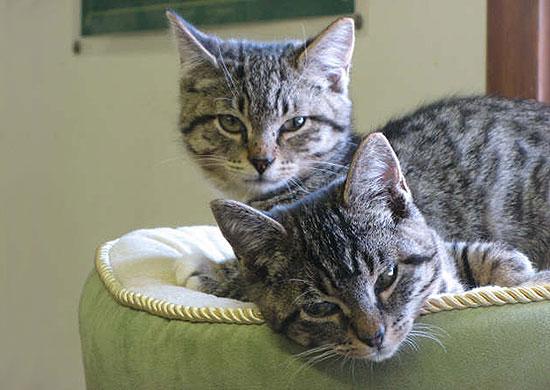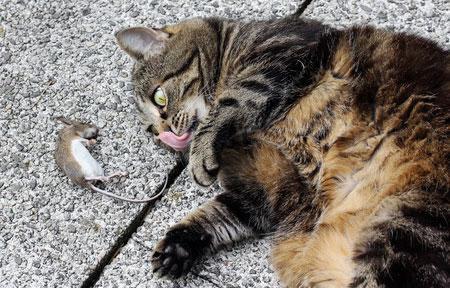This content is archived from the Feline Nutrition Foundation
Spooked By Salmonella: Raw Cat Food!
- Updated: Sunday, June 02, 2019 02:18 PM
- Published: Thursday, March 04, 2010 11:01 AM
- Written by Margaret Gates
 You may have concerns when considering raw food for your cat. What about bones, parasites and proper nutrients? And what about pathogens such as salmonella? We have all been warned our entire lives about cooking meat thoroughly. The idea of feeding uncooked meat to our cats can seem scary at first. Isn't raw cat food dangerous? Not at all. People all over the world are feeding their cats raw food. The risk from pathogens and parasites is minimal if you follow safe-handling procedures and are careful about sourcing the meat and supplements. It's the same as you would do with foods intended for your own consumption. Cats eating a wild, prey-based diet routinely eat raw bone; it is a vital part of a natural diet. As obligate carnivores, cats evolved to eat their prey raw. Their digestive systems are specialized for getting the maximum nutrition from a bio-appropriate diet.
You may have concerns when considering raw food for your cat. What about bones, parasites and proper nutrients? And what about pathogens such as salmonella? We have all been warned our entire lives about cooking meat thoroughly. The idea of feeding uncooked meat to our cats can seem scary at first. Isn't raw cat food dangerous? Not at all. People all over the world are feeding their cats raw food. The risk from pathogens and parasites is minimal if you follow safe-handling procedures and are careful about sourcing the meat and supplements. It's the same as you would do with foods intended for your own consumption. Cats eating a wild, prey-based diet routinely eat raw bone; it is a vital part of a natural diet. As obligate carnivores, cats evolved to eat their prey raw. Their digestive systems are specialized for getting the maximum nutrition from a bio-appropriate diet.
Salmonella and E. coli
Concerns about salmonella and e. coli are usually the first worry. They are generally the product of improper slaughtering methods or improperly-raised animals. Neither of these pathogens should ever be in meat intended for humans or animals.
Most people are naturally cautious and careful when handling raw meat. Salmonella contamination occurs on non-meat or cooked products when food is cross-contaminated with a contaminated raw product, as has happened with commercial dry pet food. Following safe handling procedures and using only fresh meats from known sources minimizes the risk.
 Salmonella contamination in meat is usually on the outside of a cut, so grinding meat spreads the contamination throughout and provides a large surface area for the bacteria to grow. Buying grocery store or frozen ground meats that are intended for human consumption is risky. You don't know how long the meat was left unfrozen after it was ground. Remember, the producers of human-grade pre-ground meat are counting on it being cooked to destroy any pathogens that may exist due to their practices. Meat ground for raw cat food is frozen immediately after grinding to help avoid bacterial proliferation.
Salmonella contamination in meat is usually on the outside of a cut, so grinding meat spreads the contamination throughout and provides a large surface area for the bacteria to grow. Buying grocery store or frozen ground meats that are intended for human consumption is risky. You don't know how long the meat was left unfrozen after it was ground. Remember, the producers of human-grade pre-ground meat are counting on it being cooked to destroy any pathogens that may exist due to their practices. Meat ground for raw cat food is frozen immediately after grinding to help avoid bacterial proliferation.
Cats have highly acidic digestive systems. This acidity makes them pathogen resistant. They also have a short digestive tract that gives bacteria little time to proliferate in their systems. Food passes through in about 13 hours, compared to two to three times that long for a human.¹ If a cat ingests salmonella bacteria, it has a good chance of not being affected by it. Keep in mind this applies to a healthy cat; resistance can be severely diminished in a cat that is ill. The concern is more about the people in the household – most of the emphasis on safe handling is to protect humans.
E. Coli is found in the gut of animals and can contaminate meat if it is not slaughtered properly. Grass-fed cattle have a much lower incidence of e. coli in their gut.² Even though contamination of meat products with e. coli is rare, care must be taken to source meat from reputable providers.
Toxoplasmosis
Toxoplasmosis is caused by a single-celled parasite. It is one of the most common parasitic diseases. In the U.S., approximately 22.5% of the human population has been infected.³ With the exception of pregnant or immune-deficient humans, toxoplasmosis rarely causes significant disease in any species. However, a study from the University of Leeds published in March 2009 indicates that the toxoplasmosis parasite may play a role in the development of schizophrenia and other bipolar disorders in humans by affecting the production of dopamine in the brain. Cats, both wild and kept, are the only species that host the egg-producing phase of the organism. As any infected cat would be shedding the parasite's eggs for only a few days in its entire life, the risk of infection from a cat is small. Humans are more likely to be infected by eating raw meat themselves or from unwashed fruits and vegetables than by handling cat feces, as the eggs have to be ingested to cause infection.
Contact with contaminated soil is a common means of infection. Freezing meat for 72 hours at -4°F (-20°C) kills toxoplasmosis eggs.⁴ Keep in mind that eggs shed in cat feces are not immediately infectious. They must go through a process called sporulation, which takes from one to five days depending on the environment.⁵ This is another reason to promptly clean the litter box.
If you are planning or at risk of geting pregnant, have a test done to see if you have been exposed to toxoplasmosis. If you have been exposed previously and developed antibodies, re-infection is unlikely. Cases of re-infection during pregnancy are rare, and thought to be infections from a different strain of the parasite.⁶ If you haven't been exposed, wear gloves when cleaning the litter box, or better yet, have someone else do it. Avoid handling raw meat and coming in contact with soil while gardening outdoors. You do not have to get rid of your cat. As always, talk with your doctor first to protect your health.
Bones
Contrary to popular belief, raw bone is highly digestible and provides calcium, minerals and enzymes. The marrow is nutrient rich. It is only cooked bone that is dangerous. Cooking makes bone sharp, brittle and almost impossible to digest.⁷ Cats that hunt eat the bones of their prey; bones are their primary source of calcium. Feeding your cat small, raw meaty bones is a natural way to provide calcium and give your cat some chewing exercise for healthy jaws and cleaner teeth. Chicken wings or Cornish game hen bones are about the right size. It is always a good idea to supervise your cat when feeding raw meaty bones.
Nutrients
 Cats have been eating their food raw for millennia. It is only recently that humans thought they could do better with a highly-processed, cooked and packaged diet. Raw cat food tries to emulate a diet that kitty would be eating if she were hunting her own food. The digestive system of a cat is specialized to deal with raw food that is high in protein, high in moisture and has little or no carbohydrates. As an obligate carnivore, your cat should get most of the required nutrients from the food directly, in a form she is adapted to utilize most efficiently.
Cats have been eating their food raw for millennia. It is only recently that humans thought they could do better with a highly-processed, cooked and packaged diet. Raw cat food tries to emulate a diet that kitty would be eating if she were hunting her own food. The digestive system of a cat is specialized to deal with raw food that is high in protein, high in moisture and has little or no carbohydrates. As an obligate carnivore, your cat should get most of the required nutrients from the food directly, in a form she is adapted to utilize most efficiently.
If your cat were to eat a varied, fresh prey diet, she would get all of the nutrients she requires directly from her food. This kind of diet is not practical for indoor companion cats. Frankenprey diets, consisting of varied whole parts of animals fed so that a nutritional balance is attained over a set period of time, are the next closest to prey-based diets. Properly planned, this type of diet usually requires no supplementation. It's often not practical for many people, and cats sometimes will not eat it. Feeding a ground raw cat food diet is the easiest and most practical method, but grinding and freezing causes some loss of nutrients. Supplements are required to be certain your cat gets enough essential nutrients.
Whatever method of feeding you choose – ground, frankenprey or a combination of the two – variety is important. Meats vary in their nutritional profile, and feeding a range of meats provides the best overall assurance of proper cat nutrition.
Additional Reading
Safe Handling Practices for Raw Meat
How Toxoplasmosis Affects Cats
When Feeding Raw Cat Food, Follow Safe Handling Procedures:
- Use meat that is as fresh as possible, from a reputable source, and rinse it to help remove surface bacteria.
- Never buy supermarket ground meat. You don't know how long it has been sitting around, growing bacteria. Also, you don't know the cleanliness of the grinding equipment.
- When grinding your own, freeze it immediately after processing. Only refrigerate portions that will be eaten right away.
- Keep your equipment, bowls and surfaces squeaky clean. Use a cat-safe vinegar and water sterilizing solution on surfaces that your cat comes into direct contact with.
- Avoid cross-contamination of utensils, surfaces, foods and hands.
- Discard food that has been sitting out too long.
- Thaw frozen meat properly in the refrigerator, never at room temperature.
- Warm raw cat food in a baggie in a bowl of warm water. Do not microwave it. This only cooks it, which reduces the available nutrients you've worked so hard to get. Cooking makes any bone in the food brittle, indigestible and possibly dangerous.
- For serving raw food, use metal or glass plates or bowls. Plastic can develop scratches that can harbor bacteria. Alternatively, you can use paper plates and throw them out after use.
- It's a good idea to always wear gloves when handling raw meat.
Most importantly of all, wash your hands! You can't be too careful.
Margaret Gates is the founder of the Feline Nutrition Foundation.
1. U.S. National Research Council Ad Hoc Committee on Dog and Cat Nutrition, Nutrient Requirements of Dogs and Cats, 2006, 5-10.
2. J. B. Russell, F. Diez-Gonzalez, and G. N. Jarvis, "Potential Effect of Cattle Diets on the Transmission of Pathogenic Escherichia Coli to Humans," Microbes and Infection 2.1, Jan 2000, 45-53.
3. "Toxoplasmosis," Centers for Disease Control.
4. "Toxoplasmosis and Cats," International Cat Care, UK.
5. "Toxoplasmosis in Cats," Cornell University College of Veterinary Medicine.
6. A. Elbez-Rubinstein, D. Ajzenberg, M. L. Dardé, R. Cohen, A. Dumètre, H. Yera, E. Gondon, J. C. Janaud, and P. Thulliez, "Congenital Toxoplasmosis and Reinfection During Pregnancy: Case Report, Strain Characterization, Experimental Model of Reinfection, and Review," Journal of Infectious Disease, January 15, 2009.
7. Dr. Bruce Syme, BVSc (Hons), "Feeding Raw Bones to Cats and Dogs."




